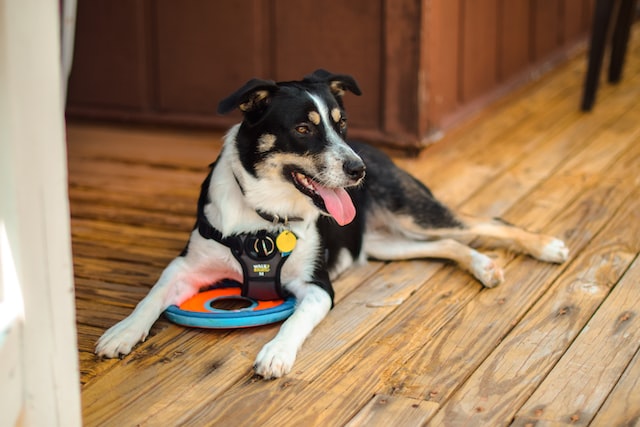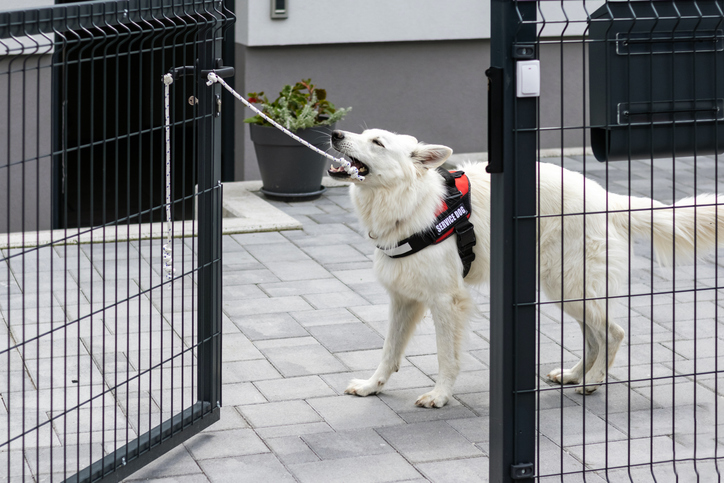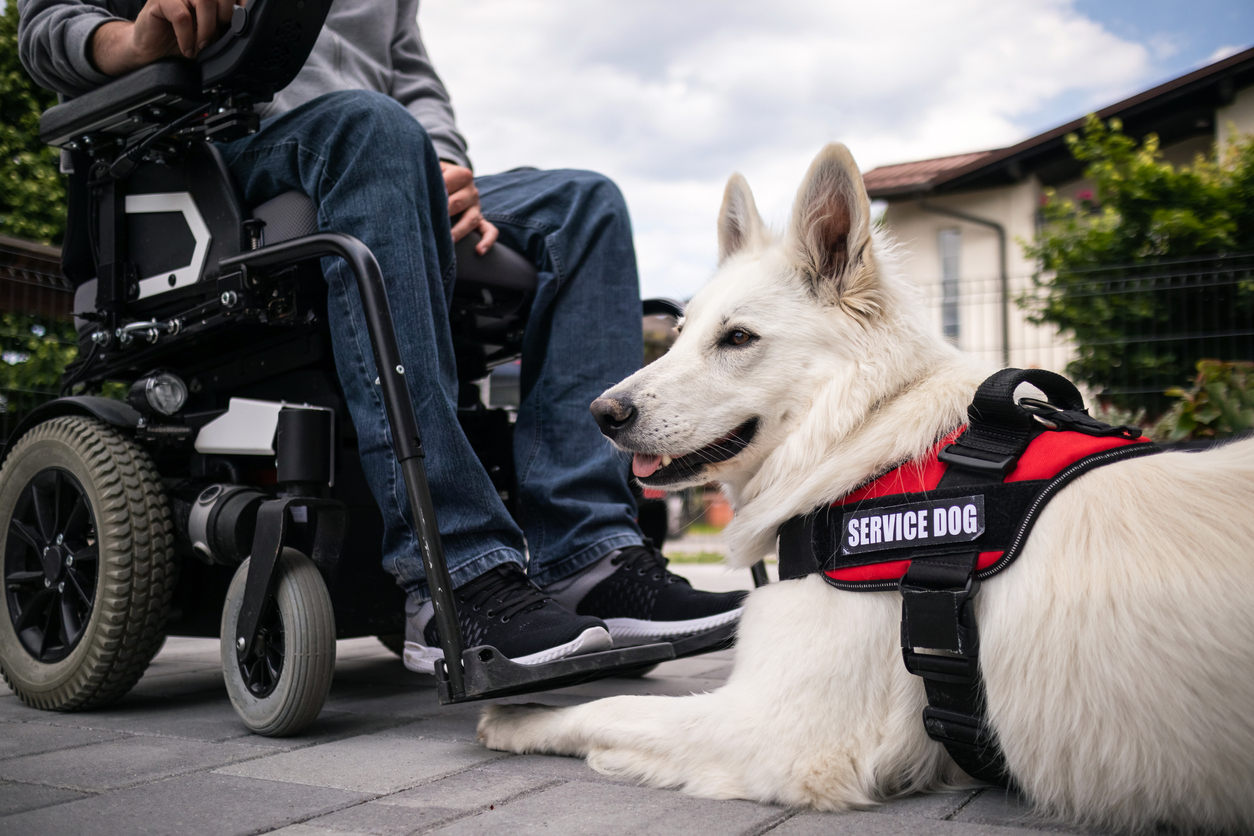Owning a service dog will improve your life in countless ways. If you’re interested in having a service dog, it’s essential to know how to train them and set up your home to be conducive to success. Service dogs can help people with various disabilities, even learning tasks and commands. It might surprise you that people have been using service dogs since the Civil War, and the first official school for these dogs opened in Germany in 1916. Today, there are approximately 500,000 service dogs in the United States alone. Read on to learn how you can set up your home for a service dog to ensure a happy, fruitful life.
What is a service dog?
Service dogs provide a range of helpful “services” to those dealing with an illness, disorder, or disability — from blindness to anxiety, PTSD, Autism, depression, Traumatic Brain Injury, ALS, Arthritis, Cardiac-related disabilities, Cerebral Palsy, Chronic back/neck problems, Chronic Fatigue Immune Dysfunction Syndrome, Diabetes, Epilepsy/seizure disorders, Fibromyalgia, Multiple Sclerosis, Muscular Dystrophy, Myasthenia Gravis, Narcolepsy/Cataplexy, Paralysis, Parkinson’s Disease, Spina Bifida, Spinal Cord Injuries, Stroke, and Vertigo.
Some of these animals may not be categorized as service animals but as “assistance animals,” depending on the issue they support. Service dogs are typically trained to perform specific tasks for a diagnosed issue, like guides for the blind, helpful companions for deaf people, seizure alert dogs, and wheelchair assistance dogs.
Psychiatric Service Dogs (PSD) are trained depending on the type of support they will be providing. They can help by responding to severe health issues by looking at behavior or breathing pattern changes, recognizing a panic attack, or helping someone who is having a dissociative disorder. They can help regain balance for someone who suffers from vertigo and provide calming relief by reassurance via physical contact.
PSDs may help people with disabilities like phobias, bipolar disorder, ADD and OCD, and Autism Spectrum Disorder by providing tactile therapy, companionship, and help with uncomfortable situations. They can help with other mental health disorders like depression, anxiety, or PTSD since they give people affection and stress relief. They can even be trained to recognize manic or depressive episodes. They can also offer brief therapy for children in schools or people in hospitals. Many organizations use therapy dogs to help several people in the community rather than directly to their owners. They’re usually certified and evaluated by organizations backed by the AKC and must have an excellent disposition to be allowed in a public place.
Emotional support dogs provide comfort to a person and don’t need specific training. These dogs can be any breed, but the owners may not have the same public access rights as owners of service or therapy dogs do.
In some cases, airlines will allow passengers to bring their emotional support dog (or other animals) on board, while laws permit service dogs to ride on board.
The cost of service dog ownership

The cost of a service dog can vary depending on the breed, but plan to budget between $15,000 to $30,000 if you want to own one for life. Some of this cost includes the typical needs associated with owning a pet — such as vet visits and medications, vaccinations, food, toys, and general care. Every dog owner, regardless of whether it’s a service dog or not, pays anywhere from $500 to $10,000 each year to care for every pet they have. However, service dogs also require special training, which costs between $150 to $200 per hour if you’re hiring a professional dog trainer with experience in specialized service training. Your total cost will vary based on how long your particular dog takes to “pass” the training and get certified. The more complex tasks the dog must learn, the longer training typically takes. If you need help financing a service dog, some organizations have dedicated their efforts to assisting dog owners. These usually include military veterans, visually impaired people, and people with certain physical disabilities. Look for help and grants to get a service dog so you can pay for its training and care and enjoy the benefits they offer.
How to get a service dog
Getting a service dog or a dog for disabilities ensures you are getting the help you need. Here are some tips to help you get your service dog — including how much you should expect to pay and how to find programs that offer financial assistance to lessen the cost. Fortunately, several grants and financial assistance programs are available to those who could benefit from owning a service dog. Here are some examples of a few resources you may be able to qualify for, depending on your unique circumstances.
Financial assistance for veterans
The VA (Department of Veteran Affairs) offers several service dog options and can refer you to specific accredited agencies. Many organizations don’t charge you for the dog or the training. Some examples include the following:
Financial assistance for those with autism or physical disabilities
People with Autism or other physical disabilities can benefit from owning a service dog. These dogs may help with behavior disruption and search and rescue tracking when applicable. They may also help with mobility issues from MS, spinal injury, cerebral palsy, amputation, or visual and hearing impairment. Here are some programs for these specific types of dogs:
- Can Do Canines
- Canine Companions for Independence
- Dogs for Better Lives
- Paws with a Cause
- Canine Partners for Life
- Service Dogs, Inc.
- Service Dog Project (SDP)
- Canine Partners of the Rockies
Financial assistance for those with visual impairment
Seeing-eye dogs, or guide dogs, are an invaluable asset to those with blindness or other visual impairments. Here are some examples of grants and other financial assistance programs designed to help those with these issues obtain a service dog.
- Guide Dogs for the Blind
- Guide Dogs of America
- Guide Dogs of the Desert
- Guiding Eyes for the Blind
- The Seeing Eye
Try to obtain help from service dog organizations accredited by Assistance Dogs International (ADI). This organization sets the industry standard for people who train service dogs while serving as a benchmark for excellence in the industry. ADI requires all service animal programs to meet specific administrative and facility standards — including providing dogs with clean kennels and training facilities while demonstrating financial transparency. Each accredited organization must also operate as a nonprofit. You don’t have to use an ADI-accredited program to get a service dog, but it is highly recommended.
There are a few legal considerations supporting your efforts to have a service animal in many homes, restaurants, and buildings. Make sure you register your service dog to be able to be with it anywhere you go where service animals are allowed.
Service dogs are an important part of many households, so it’s essential to review your home insurance policy to ensure that it adequately covers both your home and your faithful companion.
Modifying your home for a service dog

Now that you know more about what these animals do, how much they cost, and how to get one, it’s time to optimize a home for a service dog. Just like you may need to modify your home to meet your needs, and take the same considerations for your new furry companion.
Inside the home
- Hallways: Keep the hallways in your home free from obstructions, move wall art to a higher level, or relocate it to another room. This path should be free and clear so your new service dog can easily maneuver throughout the house. Provide adequate lighting for you and your dog, install mirrors, or paint the walls bright so it’s easier to see.
- Kitchen: Add “tugs” to the fridge door and any cabinets you want your service dog to access. Keep dangerous items like household cleaners out of reach and the things you need to access at waist height so you and your dog can reach them. Talk to your trainer about the specific tasks you need help performing in the kitchen.
- Doors and doorways: If possible, retrofit your doorways and make them wide enough so your wheelchair and dog can enter through them together (when applicable). You can also add tugs to the doors so they’re easy for your dog to open and remove locks on interior doors to prevent accidentally locking your service dog in or out of a room.
- Living room: Keep your living room open and clutter-free so your service dog can navigate it. Use bins or baskets to hold onto toys, extra throw blankets, and other items you don’t always need to have out. Keep cords and wires securely bundled together and tucked away behind furniture so your dog doesn’t try to chew on them. Also, don’t forget to pet-proof your fireplace.
- Bathroom: Install nonslip flooring for the safety of yourself and your dog. Install grab bars in the shower and by the toilet for extra support. Determine where your dog will be whenever you’re in the bathroom, and try to make this area comfortable while they stand watch. Keep medications and cleaning supplies safely locked away and out of reach, but everyday items like your hairbrush or toothbrush easily accessible.
- Bedroom: Add a comfortable pet bed to your bedroom so your service dog can sleep in the same room with you in case of an emergency. In some cases, your dog can even sleep with you to detect issues like nighttime seizures or other problems. If you use a separate pet bed, place it in an area out of your direct path to avoid tripping hazards in the middle of the night.
Outside the home
- Driveway and garage: Make sure your garage door is 12 feet wide or more for easy access, and trim any hedges or shrubs lining the driveway to remove obstructions. Add a non-slip additive to garage floor coatings for safety, and keep your garage organized and free of clutter. Use shelving to store items you don’t use regularly, and keep the floor swept so it’s clean and free of debris and grime.
- Sidewalks and paths: A width of between 24 and 48 inches is ideal for access so you and your service dog can walk next to each other. Those who use a wheelchair should have a minimum of 36 inches up to 60 inches whenever possible. Keep shrubbery and plants to a minimum so it’s easy to maneuver down your walkway.
- Yard: Make sure you have a sturdy fence installed to keep your dog secure, and include a gate that’s easy to open and close. A secure fence can prevent your dog from escaping when unsupervised. Your dog should be able to open the gate only under your supervision and be kept locked at any other time. If you own a pool, make sure proper safety measures are in place to keep your furry friend safe. Keep the yard clean and free of clutter or debris so it’s easy to maintain and will keep your dog safe. If you feel like you need assistance to accomplish those adaptations, you can hire a general contractor to make sure everything is set up properly.
Other considerations for planning for a service dog
The most important way to prepare your home and take good care of your service dog is to make sure that everything is clear and open with distinct, easy-to-follow pathways. Keep items on the floor to a minimum, and establish a fire escape route for every room so you can get out quickly if needed. You can even do some occasional practice fire drills with your dog so they understand what to do in such an emergency. Keep an emergency bag handy and show your dog where it is. Practice having the dog “grab” the bag and bring it to you just in case you need it. Teach your dog to grab vital medications in a medical emergency, too. If you have a home alarm, ensure your dog understands what to do if it goes off. Some dogs even know how to dial 911, which is certainly something worth considering. It’s also essential to keep your dog well-groomed. If you can’t get out and about, look for mobile dog grooming services that will come to you.




